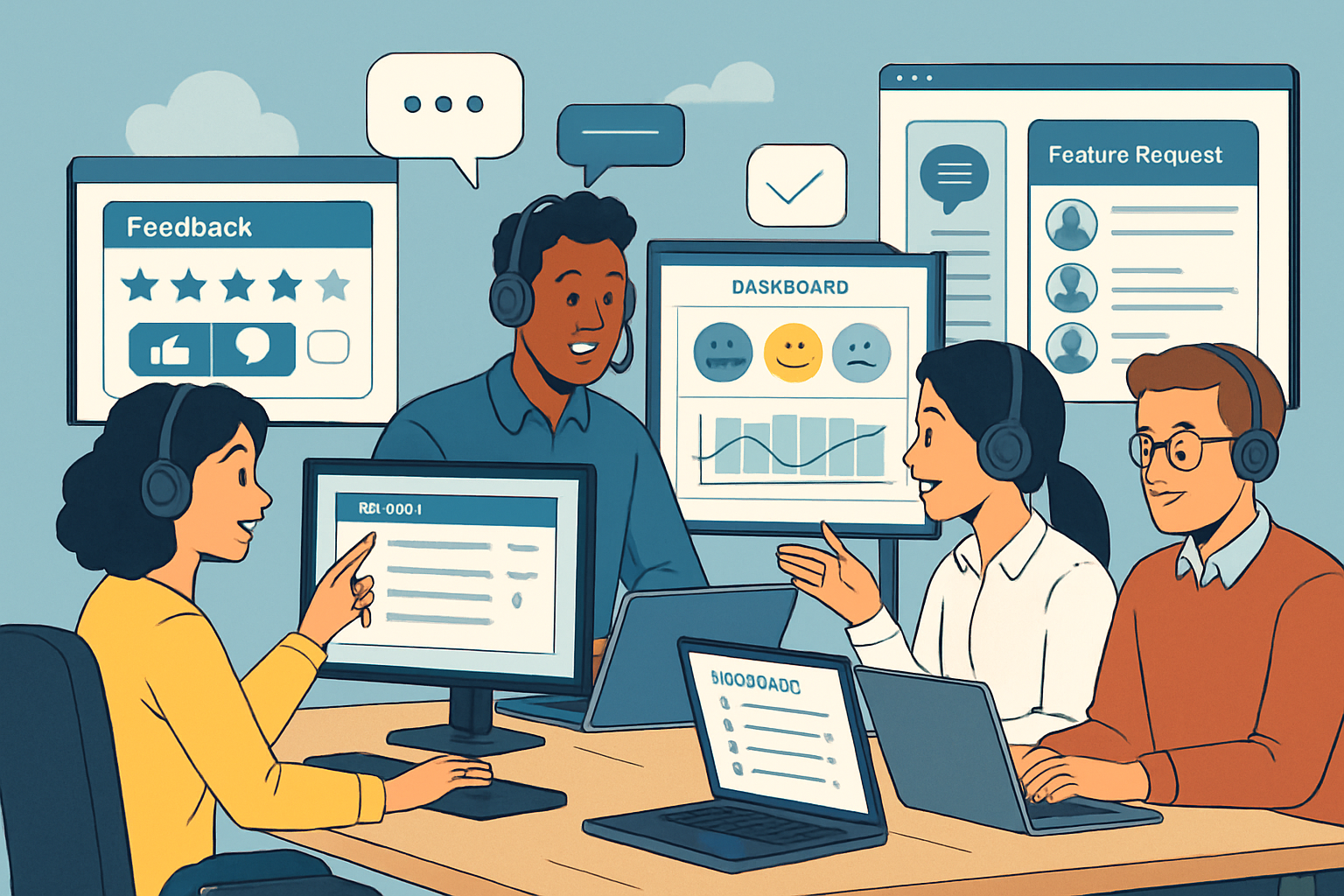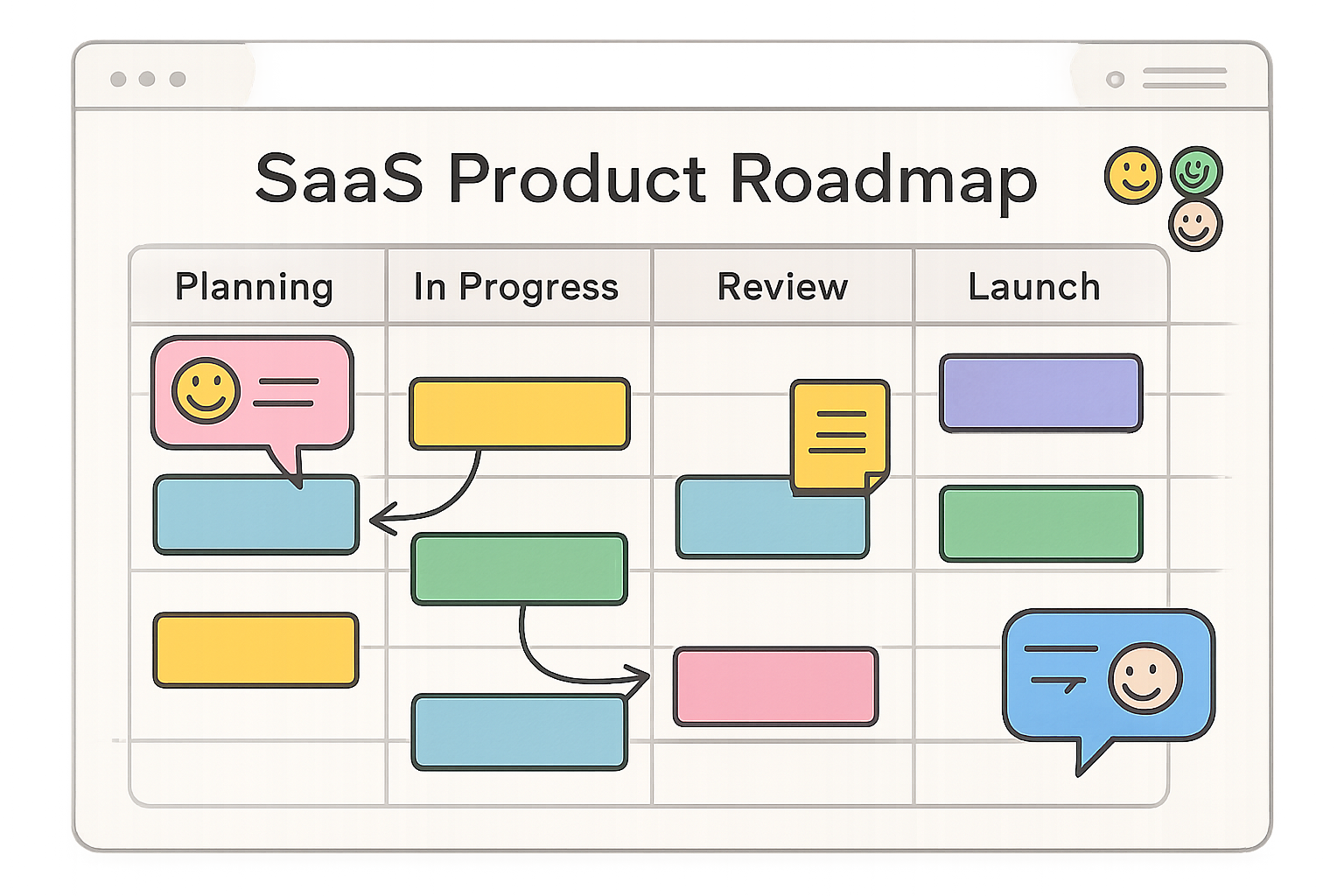In the dynamic world of SaaS, customer feedback is not just a helpful tool—it is a vital cornerstone for driving growth, enhancing user experience, and sharpening your competitive edge. As SaaS businesses evolve in 2025, the way companies gather, interpret, and incorporate feedback into the sales funnel has become more sophisticated and strategic. Business thrive when feedback is seamlessly integrated at every stage of the customer journey, ensuring products align closely with real user needs and expectations.
Acquiring actionable feedback goes beyond collecting sporadic comments. It involves creating continuous, responsive channels for communication with customers, leveraging advanced tools like Salesforce, HubSpot, or Zendesk to provide structured feedback loops. These platforms enable timely insight aggregation that informs every stage of the SaaS sales funnel from lead capture to conversion, and even retention.
However, the challenge many SaaS providers face is treating feedback as a one-time event rather than an ongoing dialogue. When feedback systems stagnate, companies risk missing evolving user concerns and innovative ideas, which can be crucial in a fast-paced marketplace. By making customer feedback an integral, iterative process, SaaS vendors can continuously optimize and adapt their product and sales approach to meet marketplace demands effectively.
In this comprehensive exploration, we will delve into practical strategies to embed customer feedback effectively into your SaaS sales funnel. From setting up robust channels and appreciating customer input to building transparent product roadmaps and measuring feedback influence, these approaches will empower SaaS companies to improve their conversion rates and foster deeper customer loyalty.
Setting Up Effective Customer Feedback Channels for SaaS Sales Funnel Optimization
Successful incorporation of customer feedback into your SaaS sales funnel begins with establishing efficient, accessible channels that encourage users to share valuable insights continuously. These channels form the backbone of a responsive and user-centric sales strategy, enabling your business to listen carefully and adapt swiftly.
Various tools are available to facilitate this process, each offering distinct features that can align with different stages of the sales and customer journey. For example, Intercom and Freshdesk excel at handling real-time conversations and support tickets, allowing customer queries and concerns to translate organically into feedback items. Meanwhile, platforms like Canny or Nolt specialize in feature requests and bug reporting, seamlessly integrating with product management workflows.
Integration of a tool such as Monday.com can help coordinate feedback collection across teams—sales, marketing, support, and product development. Centralization ensures that no valuable customer insight slips through the cracks. Additionally, leveraging survey tools like SurveyMonkey or Typeform can capture structured feedback, allowing businesses to quantify customer sentiment and prioritize needs effectively.
Here is a practical checklist for creating effective customer feedback channels:
- Create multiple feedback touchpoints: Embed feedback buttons within your SaaS application, initiate post-interaction surveys, and incorporate feedback requests in email campaigns to maximize reach.
- Ensure accessibility: Feedback tools must be easy to use and seamlessly integrated into user workflows to encourage higher response rates.
- Train customer-facing teams: Equip sales, support, and success teams to recognize valuable customer insights and consistently log them into the feedback system.
- Use CRM and support software integration: Link platforms like Zoho or Pipedrive with your feedback tools to maintain context around suggestions related to specific clients.
- Schedule regular feedback reviews: Commit to routine evaluation meetings where collected feedback is analyzed by product managers to inform the sales funnel adjustments.
| Tool | Best Use Case | Key Integration | Primary Benefit |
|---|---|---|---|
| Intercom | Live chat & customer support | CRM systems, Marketing tools | Real-time user engagement and feedback |
| Canny | Feature requests & bug tracking | Slack, Jira, GitHub | Streamlined customer-driven product updates |
| SurveyMonkey | Structured surveys | Email platforms, Analytics tools | Quantitative sentiment analysis |
| Monday.com | Cross-team collaboration | Project management, Support tools | Enhanced transparency and accountability |
Embedding these channels not only encourages customer communication but also solidifies the foundational feedback loop essential for sales funnel optimization. To learn more about the key structural demands of SaaS sales funnels, visit this comprehensive resource.

Transforming Raw Customer Feedback into Actionable SaaS Sales Funnel Insights
Once feedback channels are established, the next critical challenge is transforming raw, often scattered customer inputs into clear, actionable insights that directly inform sales funnel strategies. Unprocessed feedback is a goldmine, but only if curated effectively to align with your SaaS business objectives.
The process begins with categorizing incoming feedback. Typical categories include:
- Feature requests: Suggestions for new functionalities or enhancements to current capabilities.
- Bug reports: Identifications of software defects or workflow issues.
- Usability concerns: Confusing or inefficient user interface components impacting user experience.
- Customer success insights: Feedback related to customer onboarding, support, or educational resources.
Proper categorization aids product managers and sales teams in prioritizing items based on customer impact and alignment with the product roadmap. Linking feedback directly to customer personas or specific clients (using tools like Zoho or Pipedrive) enriches the context and urgency.
An example is a SaaS provider receiving multiple requests for integration with Salesforce. This insight suggests that the lead generation and sales pipeline stages could significantly benefit from a native integration, facilitating smoother workflows for users and enhancing conversion rates.
Feedback evaluation should also address the “why” behind each suggestion, not just the “what.” Understanding the pain points customers face—for example, a missing integration costing a salesperson a deal—prioritizes development efforts with measurable business impact. This approach highlights feedback’s role in transforming product and sales alignment, which is crucial as competition intensifies.
| Feedback Type | Example | Impact on Sales Funnel Stage | Actionable Response |
|---|---|---|---|
| Feature Request | Integration with HubSpot CRM | Lead nurturing & conversion | Develop and prioritize integration roadmap |
| Bug Report | Unresponsive dashboard elements | Trial & evaluation phase | Rapid bug fix sprint |
| Usability Concern | Complex onboarding flow | Customer onboarding | Redesign onboarding UX |
| Customer Success Insight | Request for more tutorials | Retention & expansion | Create educational content |
Additionally, SaaS teams should acknowledge and thank customers who provide meaningful feedback. This recognition enhances customer loyalty and encourages future input. Transparency about feedback handling creates trust, an indispensable asset for any B2B SaaS brand. For insights on enhancing engagement in your sales funnel, visit this detailed guide.
Building a Transparent Product Roadmap by Incorporating Customer Feedback
Transparency is a transformative element when incorporating customer feedback into your SaaS sales funnel. A visible, shared product roadmap connects your development priorities directly with customer-driven inputs, demonstrating that you listen and act.
The primary goal of such a roadmap is to clearly communicate the status of feedback-driven improvements without overpromising. SaaS customers appreciate honesty about timelines and resource constraints, which helps manage expectations and fosters goodwill, even with long development backlogs.
How to build an effective feedback-driven roadmap:
- Centralize all customer suggestions: Use integrated tools to consolidate feedback, ensuring everyone across teams can view and understand ongoing discussions.
- Prioritize by impact and feasibility: Consider how suggestions affect sales stages and customer success.
- Set realistic advance notices: Communicate planned timelines clearly without committing to fixed release dates prematurely.
- Regular updates: Publish frequent progress reports informing customers and internal stakeholders about roadmap changes or implemented features.
- Create a public feedback portal: Platforms like Canny allow your users to upvote or comment on propositions, increasing engagement and letting data guide your priorities.
Such a roadmap serves as a customer trust pillar, reinforcing that feedback leads to real product evolution and sales funnel improvements. Companies that successfully utilize this approach often see increased conversion and retention rates, as buyers feel their voices genuinely influence the product’s direction.
Transparency in feedback handling is also advantageous when negotiating enterprise sales, where decision-makers scrutinize responsiveness and customer support quality before commitment. It is essential to align sales, support, and development teams to foster that transparency consistently.
| Roadmap Element | Purpose | Benefit to Sales Funnel | Implementation Example |
|---|---|---|---|
| Public Feedback Portal | Engage customers in prioritizing features | Boosts conversion, loyalty | Use Canny for upvoting suggestions |
| Monthly Progress Updates | Report on bug fixes and features | Enhances trust and retention | Email newsletters, blog posts |
| Internal Feedback Meetings | Align all teams on feedback status | Improves internal coordination for sales and support | Weekly cross-department calls via Monday.com |
For comprehensive guidance on building an effective SaaS sales funnel that integrates such mechanisms, explore this complete guide.

Leveraging Feedback to Enhance SaaS Sales Funnel Conversion Rates
Customer feedback not only fuels product development but also acts as a powerful lever to refine conversion strategies at every sales funnel stage. By understanding and addressing precise customer demands, SaaS companies can accelerate leads through the funnel more efficiently.
Key conversion-focused feedback actions include:
- Refining messaging and positioning: Use language and value propositions attuned to customer pain points revealed by feedback.
- Tailoring onboarding experiences: Simplify and customize trials or demos based on usability complaints or feature requests.
- Targeted marketing campaigns: Segment prospects according to expressed needs and preferences to increase relevance and engagement.
- Cross-sell and upsell offers: Capitalize on feedback about desired integrations or add-ons to extend customer lifetime value.
- Reducing churn: Identify and remedy reasons for dissatisfaction early through proactive use of support and feedback channels like Zendesk or Intercom.
Statistics reveal that SaaS companies utilizing integrated feedback loops and CRM tools such as HubSpot experience up to a 30% higher conversion rate by delivering precisely what customers want at the right funnel stages.
Embedding newsletters, webinars, or personalized follow-ups based on feedback data significantly enhances engagement—a crucial factor in converting users from free trials to paying subscribers. Additionally, SaaS leaders increasingly turn to AI-powered analytics that mine feedback data for hidden trends, further refining funnel tactics.
| Conversion Stage | Feedback Influence | CRM/Tool Integration | Example Strategy |
|---|---|---|---|
| Lead Capture | Highlight desired features in landing pages | HubSpot, Pipedrive | Dynamic website personalization |
| Lead Nurturing | Send tailored emails addressing complaints | Salesforce, Intercom | Automated drip campaigns |
| Conversion | Incorporate requested integrations | Monday.com, Canny | Product updates announcements |
| Retention | Continuous feedback loops for loyalty | Zendesk, Freshdesk | Dedicated support and success programs |
For a deeper dive into converting more leads through your SaaS sales funnel, consider reading this focused tutorial.
Measuring and Iterating: The Ongoing Cycle of Feedback in SaaS Growth
Customer feedback is not a finite resource but a continuous stream that requires active measurement and iteration to maximize its influence on your SaaS sales funnel. Developing metrics and KPIs to assess the effectiveness of feedback integration allows your teams to gauge progress and detect areas for improvement.
Important metrics to track include:
- Feedback volume: Number of suggestions and reports received over time, indicative of engagement levels.
- Implementation rate: Percentage of feedback items actually incorporated into product improvements or roadmap features.
- Customer satisfaction scores: Changes in NPS or CSAT related to feedback-driven updates.
- Conversion rate changes: Correlations between product updates informed by feedback and funnel movement rates.
- Churn rate: Reduction of cancellations linked to addressing common customer complaints.
Incorporating this data ensures that feedback remains a central tool rather than a perfunctory exercise. Feedback loops must remain dynamic, encouraging regular communication and adaptation. This culture of active listening extends through sales, marketing, product, and support teams.
Emerging AI solutions now assist in analyzing vast feedback data sets, automatically highlighting urgent user issues or trending feature requests. Additionally, CRM platforms like Zoho and Pipedrive increasingly embed feedback analytics to predict customer behavior and adjust funnel activities accordingly.
| Metric | What It Measures | Business Impact | Tools |
|---|---|---|---|
| Feedback Volume | Customer engagement | Indicates effectiveness of feedback channels | Intercom, SurveyMonkey |
| Implementation Rate | Translation of feedback into action | Reflects product adaptability and responsiveness | Canny, Monday.com |
| Customer Satisfaction Scores | Sentiment towards updates | Drives retention and referrals | Zendesk, Freshdesk |
| Conversion Rate Changes | Sales funnel effectiveness | Measures revenue growth potential | HubSpot, Salesforce |
As you continue refining feedback integration in your SaaS operations, embracing an iterative mindset ensures sustained growth and customer delight. For a futuristic perspective on SaaS growth strategies fueled by innovation and interaction, visit this insightful article.
FAQ: Key Questions About Incorporating Customer Feedback in SaaS Sales Funnels
- Q1: How often should SaaS companies gather customer feedback?
Continuous feedback collection is ideal. Integrating feedback channels throughout the SaaS sales funnel allows real-time insights that can be used for rapid iteration and improvement.
- Q2: What tools are recommended to streamline customer feedback?
Popular tools include Salesforce, HubSpot, Zendesk, Intercom, Pipedrive, Freshdesk, Zoho, and Monday.com. For surveys, SurveyMonkey and Typeform are effective.
- Q3: How can SaaS companies prioritize customer feedback effectively?
Prioritize based on factors such as frequency of similar requests, customer impact, alignment with business goals, and technical feasibility.
- Q4: What role does transparency play in customer feedback integration?
Transparency builds trust by showing customers their feedback is valued and considered, even if implementation timing varies.
- Q5: How can SaaS companies measure the impact of feedback on sales funnel performance?
Tracking metrics like implementation rates, conversion changes, and customer satisfaction scores linked to feedback allows businesses to assess effectiveness.


